The allure of flying cars has long captured the human imagination, promising a future of decongested roads and swift travel, potentially even consuming less energy. However, a closer examination reveals that these futuristic vehicles may carry a disproportionate number of disadvantages compared to their much-touted benefits, raising serious questions about their practical viability and safety.

While proponents highlight the potential for energy efficiency, critics argue that the challenges associated with the widespread adoption of flying cars are formidable, possibly outweighing any perceived advantages.
Safety in the Sky: A Perilous Proposition
One of the most significant concerns revolves around safety and human error. Even with rigorous driving tests, road accidents claim countless lives globally due to irresponsible driving. The transition to aerial vehicles introduces a vastly more complex environment.
“If people can’t learn to drive properly on the road, will they be able to learn to fly properly?” questions an unnamed expert in the field. “It’ll be 10 times more difficult. It’ll have 10 times more scope of causing accidents. And if an accident does occur mid-air, it would be that much more deadly.”
This raises the critical question of pilot training. The sheer number of individuals who would require intensive pilot certification for personal aerial vehicles is a daunting prospect.
The Automation Dilemma and Elon Musk’s Warning
A potential solution to human error lies in automated flying cars, akin to self-driving vehicles like those developed by Tesla. If these cars could fly themselves with minimal pilot interference, the risk might be mitigated.
However, even tech visionary Elon Musk has voiced strong opposition to the idea of flying cars. According to him, the risk of thousands of aerial vehicles inevitably leading to accidents, with debris falling from the sky and potentially causing instant fatalities on the ground, is too high. “If one of those cars fell on someone’s head, that person will die instantly,” he reportedly stated.
Furthermore, roadside breakdowns, a common occurrence with ground vehicles, present an entirely new peril in the air. “If your car breaks down in the sky, where would you park it?” critics ponder, highlighting the inherent danger of mid-air failures.
Battling the Elements: Weather Woes
Bad weather conditions, such as strong winds, thunderstorms, and turbulence, pose another significant threat. While large commercial airplanes are designed to withstand such forces, smaller private jets are considerably more vulnerable. Given that personal flying cars would likely be compact, they would face similar, if not greater, risks, potentially leading to catastrophic outcomes.
Infrastructure and Regulation: A Bureaucratic Nightmare
The integration of thousands of flying cars into urban airspace demands an entirely new infrastructure. Unlike the initial deployment of a few vehicles, a future with widespread flying car usage necessitates a complex system of “air traffic lights” and sophisticated communication protocols to prevent mid-air collisions.
This level of regulation and enforcement is far from simple. Governments today struggle to regulate drones, often resorting to bans for devices used merely for aerial photography. The monumental task of creating and enforcing regulations for personal aerial vehicles, which carry human lives, is almost unimaginable from a governmental perspective.
Noise Pollution and Technological Hurdles
Beyond safety and regulation, practical issues like noise pollution are a major concern. Anyone familiar with small drones or helicopters understands the significant noise they generate. Current flying car prototypes, such as the Jetson 1 and AirCar, are reportedly very loud, rendering them impractical for use in densely populated urban environments without significant technological breakthroughs in noise reduction.
Battery life and range also present substantial limitations. Modern drones can typically fly for only about 20 minutes. Current flying car technology reportedly limits travel to around 50 kilometers before requiring lengthy recharging or refueling. For flying cars to be a viable mode of transport, vast improvements in fast-charging technology and extended range are essential.
The Ultimate Hurdle: Cost
Even if all these technological, safety, and regulatory challenges could be overcome through immense innovation, the final barrier would likely be cost. The engineering and safety requirements for such advanced vehicles would undoubtedly drive their price far beyond the reach of the average consumer, questioning their feasibility as a widespread transport solution.
Ultimately, while the dream of soaring through the skies in personal vehicles remains captivating, the myriad of practical, safety, and regulatory issues suggest that the future of flying cars may remain grounded for the foreseeable future.
Bill Gates Backs The Future Of Aviation: Breakthrough Energy Ventures Invests $107 Million In Electric Airplane Firm

Local communities near airports are preparing for a future characterized by quiet, zero-emissions air travel. The movement urges individuals to start local chapters at their airports to advocate for eco-friendly aviation practices.
The first FAA-certified electric aircraft, Pipistrel’s Velis Electro, took flight at Santa Monica Airport.
- Bill Gates’ Investment:
- Bill Gates has committed $107 million through Breakthrough Energy Ventures (BEV) to Heart Aerospace, a Swedish hybrid airplane manufacturer.
- Heart Aerospace is developing the ES-30 hybrid-electric airplane, which aims for commercial viability while supporting the broader goal of net-zero aviation by 2050.
- Industry Commitment to Net-Zero Emissions:
- The aviation sector has made a formal commitment to achieving net-zero emissions by 2050, addressing the inherent environmental challenges posed by fuel consumption and emission levels.
- Heart Aerospace Co-Founder and CEO Anders Forslund emphasizes that the ES-30 is vital for decoupling the industry’s growth from emissions.
- Funding and Investor Support:
- The Series B funding round for Heart Aerospace included new and established investors, reinforcing confidence in innovative technologies and sustainable initiatives in aviation.
- Carmichael Roberts, co-leader of BEV’s investment committee, notes the transformative potential of electric aircraft in reducing emissions and reshaping the future of sustainable aviation.
- Technical Innovations:
- The ES-30 aircraft design aims to minimize emissions, decrease noise pollution, and lower operational costs, making it ideally suited for the evolving aviation landscape.
- The company is actively seeking certification from the European Union Aviation Safety Agency, demonstrating its commitment to regulatory compliance.
- Sustainability Outlook:
- The aviation industry faces significant challenges regarding emissions due to its scale. They claim Electric and hybrid-electric aircraft represent promising solutions to these challenges.
Nikhil Kamath, co-founder of Zerodha, is working together with Bill Gates for the same mission
In a notable episode of the podcast “People by WTF,” Nikhil Kamath, co-founder of Zerodha, engaged in a revealing dialogue with Bill Gates concerning artificial intelligence (AI) and its future implications for work and society.
- Kamath’s Query: Kamath expressed his desire to immerse himself in the AI sector, even considering an unpaid position in the U.S., and sought Gates’ guidance on how to align himself with this transformative technology.
- Gates’ Response: Gates humorously advised Kamath that with his extensive business experience, he could be highly valuable to companies like OpenAI, recognizing their rapid advancement in the AI realm and the potential for significant contributions.
- Future of AI: Gates projected that AI could alleviate many traditional scarcities over the next 20–30 years, fundamentally altering perceptions of time management and work-life balance. This may facilitate earlier retirements and shorter workweeks, driving a philosophical reset in how individuals consider the value of their time.
- Societal Implications: Kamath posed that such changes might shift social hierarchies away from conventional metrics of work and income. Gates concurred, emphasizing that total equality, as envisioned in communism, is inconsistent with human nature.
- Personal Discipline: Gates underscored the importance of self-discipline in professional endeavors, advising individuals to maintain a rigorous self-assessment to achieve success.
- Broader Themes: The conversation transcended mere economic discussions, touching on topics of curiosity, relevance in business, and the necessity of aligning with future trends to remain impactful.
- Upcoming Developments: The podcast episode serves as a stimulating exchange between two industry titans, highlighting the intersection of technology, work philosophy, and personal growth, positioning listeners to consider the evolving landscape of AI and its broader implications.
- Market Landscape: In line with this discussion, other significant market movements noted in the financial landscape included:
- IDBI Bank nearing disinvestment approval.
- SEBI’s introduction of uniform rules for mutual fund breaches.
- Strong market performances with Nifty reaching record levels.
- Investor Insight: With ongoing market rallies, attention remains on investor strategies particularly in light of the AI discussions and the shaping of future workforce dynamics as highlighted by Gates and Kamath’s dialogue.
Flying Taxis in Bangalore to take off by 2029 – Nikhil Kamath
Air Taxi Startup Sarla Aviation Raises $10 Million from Accel, Nikhil Kamath, and Others
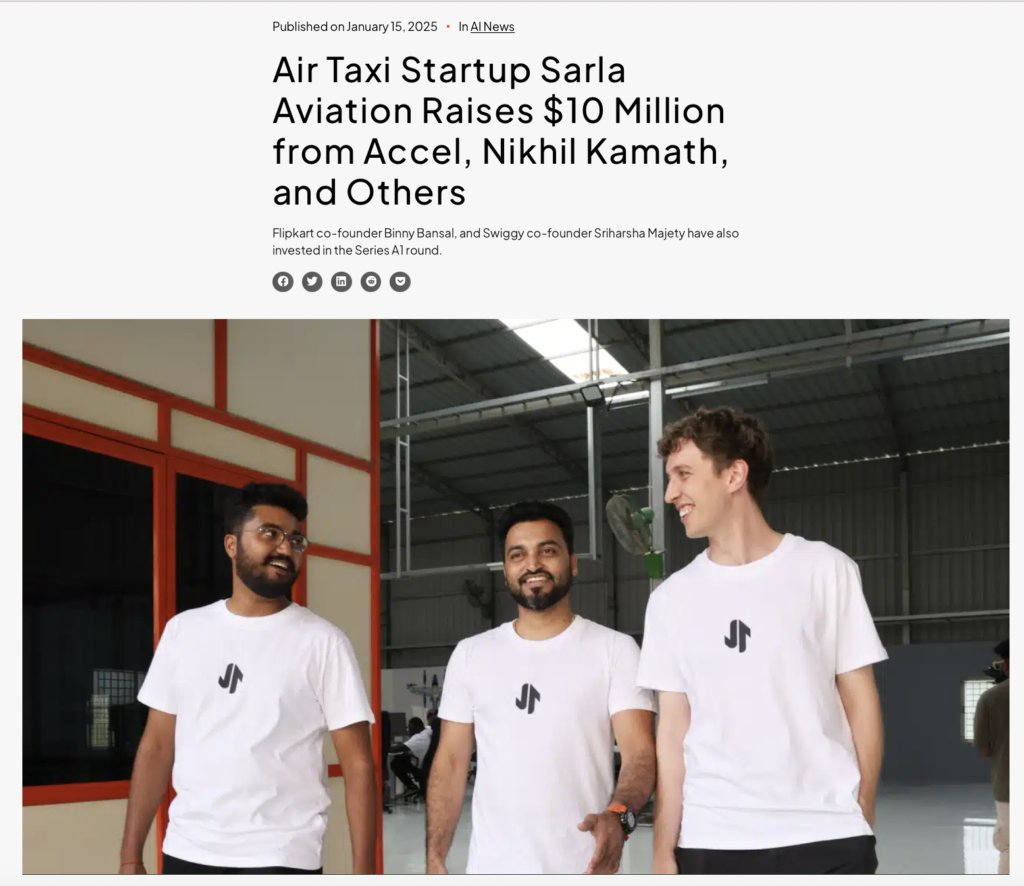
Sarla Aviation, founded in 2024 by Rakesh Gaonkar, Adrian Schmidt, and Shivam Chauhan in Bengaluru, is focused on developing electric vertical take-off and landing (eVTOL) aircraft for urban air mobility.
- Funding Achievement:
The startup has successfully raised $10 million in a Series A1 funding round led by Accel. Notable investors include:- Nikhil Kamath (co-founder of Zerodha)
- Binny Bansal (co-founder of Flipkart)
- Sriharsha Majety (co-founder of Swiggy)
- Product Launch:
Sarla Aviation is set to unveil “Shunya,” a seven-seater electric flying taxi designed to make air mobility as accessible as current ride-sharing options. - Initial Operations:
- The first commercial operations will focus on airport transfers in Bengaluru.
- Plans include expanding services to major cities such as Mumbai, Delhi, and Pune.
- Pricing Strategy:
- Initial air taxi fares will be comparable to the highest fares of Uber or Ola.
- The company aims to decrease these costs over time, targeting rates that align with typical auto-rickshaw fares in India.
- Expansion Phases:
- Phase 1: Launch air taxi services and free air ambulance services alongside commercial ride-sharing options.
- Phase 2: Facilitate direct flights between organized locations, catering to communities with rooftop landing pads.
- Phase 3 (by 2035): Position flying taxis as a standard form of mass transportation.
- Research and Development Plans:
The new funding will be allocated to establish an R&D center in Bengaluru, expand the team from 30 to approximately 120 members, and develop new prototypes for better data gathering and validation. - Related Developments in the Industry:
- Other Indian companies entering the electric air taxi market include:
- Indigo, partnering with Archer Aviation to establish an all-electric air taxi service by 2026.
- Chennai’s ePlane Company collaborating with TCS to enhance urban air mobility through AI.
- Other Indian companies entering the electric air taxi market include:
- Preceding Funding:
Prior to the Series A1 funding, Sarla Aviation successfully raised approximately $1.7 million in a seed round, also led by Accel, engaging angel investors including Rajendra Petkar, CTO of Tata Motors.
Infinium’s Project Roadrunner site is backed by Bill Gates’s Breakthrough Energy and Brookfield Asset Management


Infinium is an eFuels producer focused on sustainable fuel solutions.
Funded by Breakthrough Energy Catalyst and Brookfield Asset Management, key contributors to clean energy investments.
- Project Announcement:
- Infinium has commenced construction of its second eFuels production site, Project Roadrunner, located in Reeves County, Texas.
- This development signifies the company’s expansion efforts in the U.S. eFuels market.
- Financial and Strategic Backing:
- The project is part of a broader initiative to accelerate the transition to renewable energy solutions.
- Location Insights:
- Reeves County, Texas, has been selected for strategic advantages, including access to resources and proximity to transportation networks.
Nitin Gadkari’s Skybus Proposal for Bengaluru
Union Minister Nitin Gadkari suggested a skybus system to alleviate traffic congestion in Bengaluru. A skybus operates on elevated tracks similar to a Metro, but with carriages suspended beneath.
Capacity and Implementation:
The proposed skybus can accommodate up to 200 passengers and will be designed to run above existing roadways.
Gadkari emphasized that international expertise would be required for its implementation, noting that only two companies globally (one in France and another in Austria) specialize in skybus technology.
A preliminary report by an international consultant is expected within three months to be submitted to Chief Minister Basavaraj Bommai.
Alternative Transportation Options: In addition to the skybus, Gadkari mentioned the possibility of introducing a trolley-bus service capable of carrying 88 passengers, aimed specifically at reducing reliance on private vehicles, especially from the IT sector.
Multi-Layer Flyovers: To further address traffic woes, Gadkari proposed the construction of multi-layer flyovers within the city. He pointed out that expanding existing national highways faces limitations, thus advocating for elevated structures that integrate with Metro rail lines for improved urban mobility.
Projects: He highlighted several critical infrastructure projects intended to ease traffic in surrounding areas, including:
Bengaluru-Mysuru
Bengaluru-Chennai
Bengaluru-Vijayawada
Bengaluru-Pune
Satellite Town Ring Road expressway
Structural Updates: Gadkari announced that heavy motor vehicles (HMVs) would be permitted on the Goraguntepalya flyover after necessary repairs, addressing previous structural concerns highlighted during inspections.
Road Safety Initiatives: He urged state governments, including Karnataka, to conduct road-safety audits, as many states have not yet implemented necessary reforms to enhance transport safety.
Anticipating the mandatory blending of bio aviation fuel by 2026, Gadkari revealed collaborations with a U.S. scientist exploring the possibility of making bio aviation fuel from ethanol. Commending Indian Oil Corporation’s efforts in making ethanol from rice straw, he emphasized the commitment to sustainable aviation solutions.
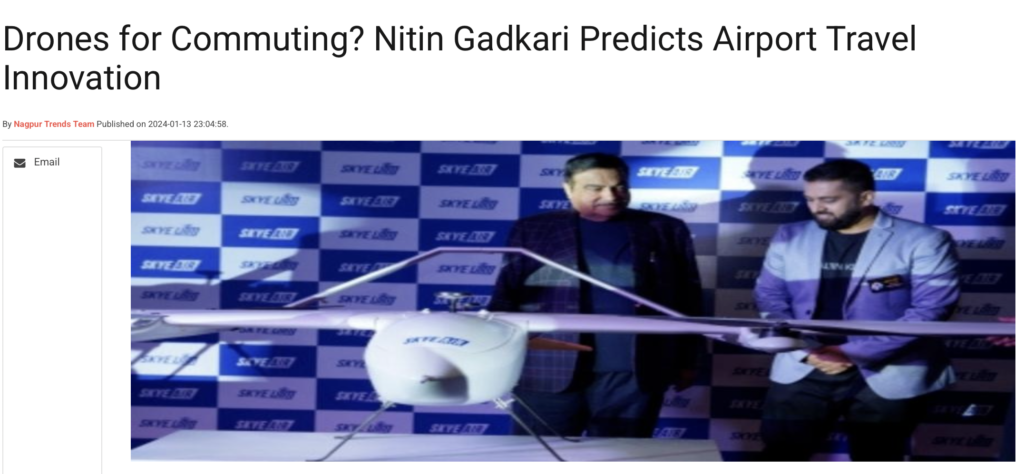
What is technology?
Many companies are working to enhance the existing technology of aircraft. Presently, aircraft need a runway for both takeoff and landing. However, many firms are striving to develop a vehicle capable of vertical takeoff and landing. In other words, this vehicle will ascend from a stationary position and land similarly. Additionally, this vehicle will operate on electricity. This concept is referred to as Electric Vertical Takeoff and Landing (eVTOL).
Airbus vehicle | Nitin Gadkari Flying Bus
Aibus, a company, built an eVTOL aircraft in 2015. It is called ‘Vahan‘. More than 130 tests have been conducted on this aircraft. This aircraft is also fully electric.
Ref: https://acubed.airbus.com/projects/vahana/
Advances in battery and electric propulsion technology have enabled entirely new types of aircraft to take to the skies. Startups Joby, Archer, Vertical, Lilium and more are developing eVTOLs, electric vertical take-off and landing aircraft, with the vision of making flying taxis a reality. CNBC got an inside look at Joby Aviation, one of the eVTOL players that has grand ambitions of not only building the aircraft, but operating an Uber-like air taxi business.
11 Sept 2024: The 7th China International Import Expo (CIIE)
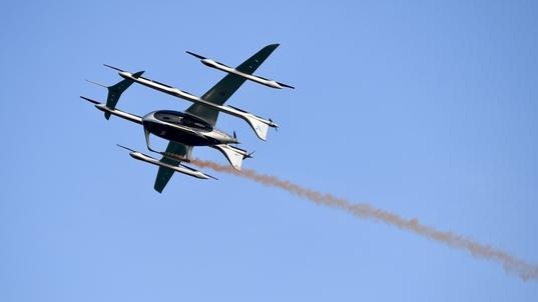
- Event Overview:
- The 7th China International Import Expo (CIIE) is attracting significant attention and participation, demonstrating China’s ongoing commitment to international trade and economic openness.
- eVTOL Aircraft Orders:
- Volant Aerotech, a Shanghai-based company, secured an advanced purchase order for over 165 electric vertical take-off and landing (eVTOL) aircraft, valued at approximately 3.5 billion yuan ($488 million).
- Major buyers include reputable firms such as China Southern Airlines General Aviation, Deer Jet, and China General Aviation.
- Cumulatively, Volant Aerotech has received intent orders for over 860 units of the eVTOL model, amounting to a total value of 22 billion yuan.
- Applications of eVTOL Technology:
- The eVTOL aircraft are expected to play a versatile role across various sectors, including:
- Low-altitude sightseeing
- Training
- Short-distance transportation
- Cargo logistics
- Emergency rescue
- Urban mobility
- The eVTOL aircraft are expected to play a versatile role across various sectors, including:
- Company Development Highlights:
- Volant Aerotech has successfully conducted debut flights of its eVTOL and has submitted its first manned eVTOL project to the Civil Aviation Administration of China (CAAC) for approval.
- The company is actively pursuing airworthiness certifications and aims to establish a production line for commercial application, indicating a forward-looking approach to the eVTOL market.
- Broader Economic Context:
- The CIIE signals broader strategies in China to promote foreign trade, reflecting government support for technology and innovation in transport sectors.
- This event foreshadows potential reforms and investments in related industries, underscoring the importance of fostering an environment conducive to technological advancements.
- Future Outlook:
- The continued evolution of eVTOL technology and its increasing integration into urban infrastructure highlight a significant shift in transportation capabilities.
- With government backing and growing domestic and international market demand, the outlook for eVTOL applications appears promising as cities adapt to new transport modalities.
eVTOL Developments
- eVTOL Technology: The emergence of all-electric vertical take-off and landing (eVTOL) aircraft is positioned to reshape urban transportation models, with over 100 companies globally involved. This technology promises a safer, quieter, cleaner, and more affordable travel solution, poised for commercial operations beginning in early 2024.
- Market Dynamics:
- Key players include established automotive and aviation firms such as Volkswagen, Hyundai, Boeing (through Wisk Aero), as well as notable start-ups like Joby Aviation and Eve Air Mobility.
- Initial routes are expected to serve short-distance flights, enhancing urban connectivity and addressing congestion issues, especially in major cities.
- Significant Developments:
- Volkswagen V .MO:
- Targeting high-net-worth customers in China.
- Features include an aerodynamically optimized cabin with eight rotors, capable of carrying four passengers over 124 miles.
- Plans for fully autonomous capability with test flights beginning soon.
- Supernal:
- A subsidiary of Hyundai, aimed for a 2028 market entry.
- Focus on creating multimodal transport solutions with vertiport infrastructure.
- Projects advantage as financially self-sufficient with no dependency on external investors.
- Vertical Aerospace:
- Introduced the VX4 with an 8-rotor design targeting a 100-mile range and speed of up to 200 mph.
- Claims a safety ratio 100 times safer than helicopters; intends to have thousands in service by 2030.
- Eve Air Mobility:
- Formerly part of Embraer; aims for a 2026 launch date.
- Focus on user-friendly design, with a 125mph top speed and 60-mile range.
- Joby Aviation:
- Plans to launch commercial services in early 2024, offering a 150-mile range and speeds of 200 mph.
- Aims to integrate services within the Uber app, with projected passenger costs of $3 per mile at scale, starting at a higher introductory rate.
- Wisk Aero:
- Develops fully autonomous flying taxis, with significant backing from Boeing.
- Recorded over 1,600 test flights; launching its sixth-generation eVTOL designed for certification.
- Volocopter:
- Features a range of craft aimed at urban mobility, including the VoloConnect for 60-mile suburban connections.
- Plans for commercial flights in Paris and Singapore by 2024.
- Volkswagen V .MO:
Going up: new players get eVTOL air taxis closer to reality
The new breed of flying taxi concepts is becoming increasingly plausible. All-electrical vertical take-off and landing (eVTOL) could transform the urban transport model. Here’s why we think this could be the next big thing.

The eVTOL craft is poised to bring change to travel patterns and urban design. If we look into this emerging tech, the scene has expanded substantially, with over 100 companies around the world working on Urban Air Mobility projects, ranging from established names in aviation and automotive, including Rolls-Royce, Hyundai, and VW, to start-ups with big-name backers like Joby and Uber and Wisk with Boeing.
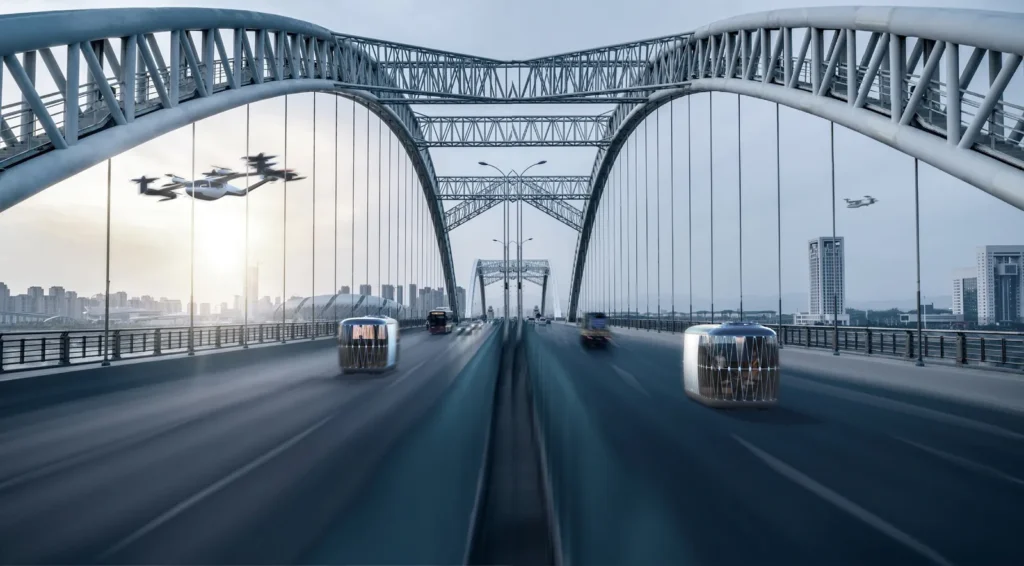
Either way, the idea is to create low-altitude transport to relieve congestion below, with vehicles that can take off and land like a helicopter but are far safer, quieter, cleaner, and more affordable, due to their multiple electric rotor redundancy, zero-emission in-use and easier prep and maintenance. They should also be much quicker than most ground-based transport shaving up to an hour off travel times on routes above busy roads, like LAX to downtown LA, or Heathrow to central London.
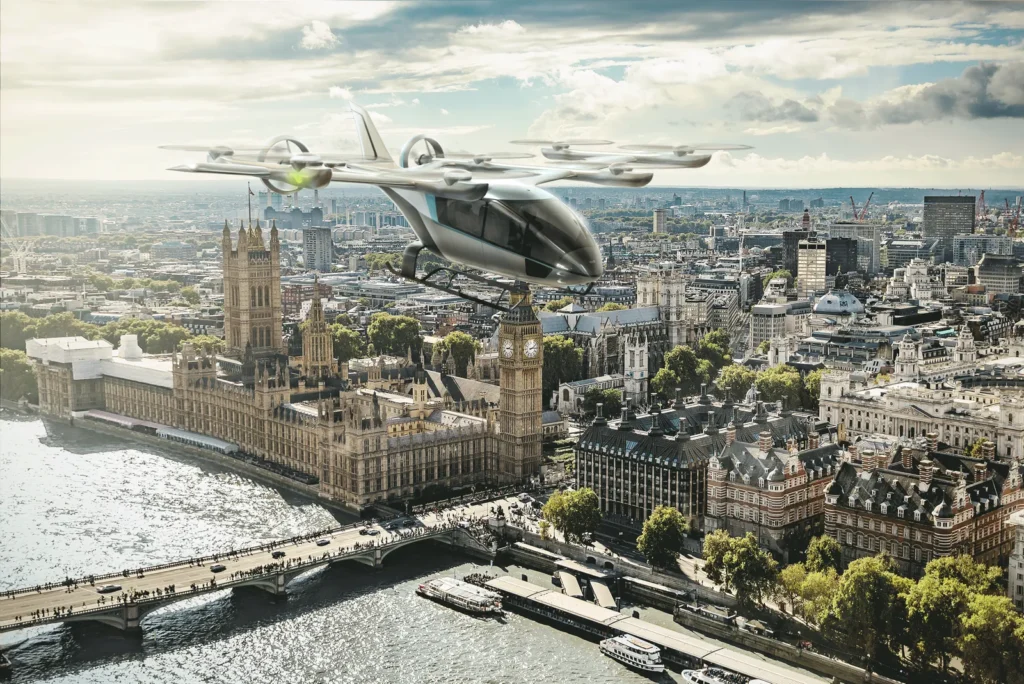
Accordingly, early routes targeted are short-hop, intra-city flights – shuttling a handful of humans at a time from airports on the outskirts into city centers, where a private cab or public transport is slower, more congested, and/or an unpleasant travel experience. But the technology could also help with cargo, medical, or even emergency situations due to the smaller space required to take off and land. After visiting the recent UK Farnborough Air Show and beyond, Wallpaper* rounds up the latest in this new form of transport that could start flying paying passengers from early 2024, perhaps for the price of a top-end Uber.
1. Volkswagen V.MO
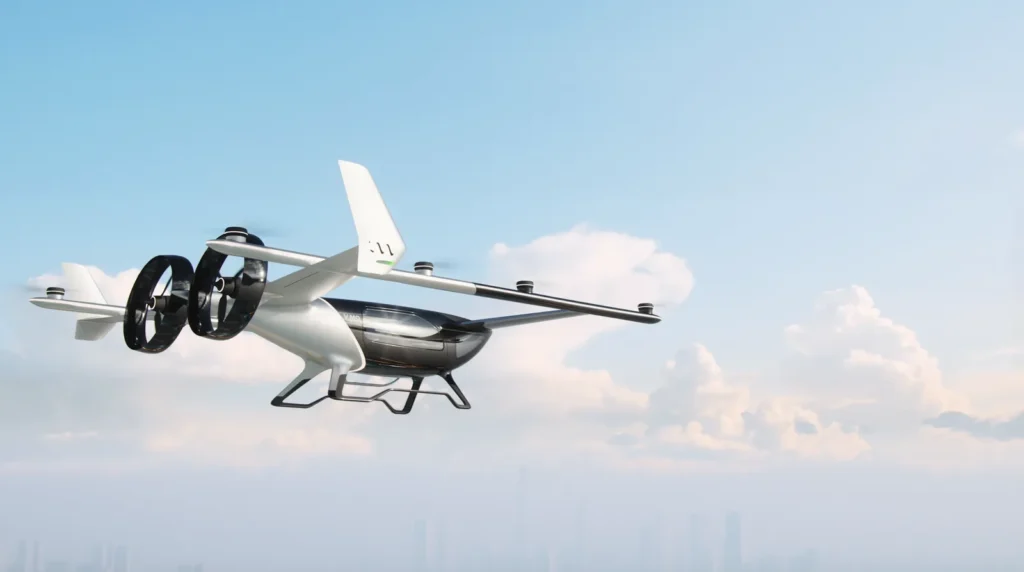
Volkswagen might translate to ‘the people’s car’ in German but its latest eVTOL design – V.MO prototype 001 – is firmly targeting Chinese high-net worth customers, at least at first. VW’s latest exterior design, created by British-born international agency Tangerine for VW’s China division, proposes an eVTOL with an aerodynamically optimised cabin, eight rotors for vertical take-off and landing and two propellers for horizontal propulsion.

Volkswagen Group China, Volkswagengroupchina.com
2. Supernal

Supernal became a brand within the Hyundai Motor Group in 2021 and the Group’s president, ex-NASA veteran Dr. Jaiwon Shin, is now CEO of Supernal too. Its six-rotor eVTOL is designed to transport up to four passengers with a pilot but the company is also exploring cargo configurations of its plane and the ‘vertiport’ infrastructure on which it can land and then connect to other forms of transport as well.
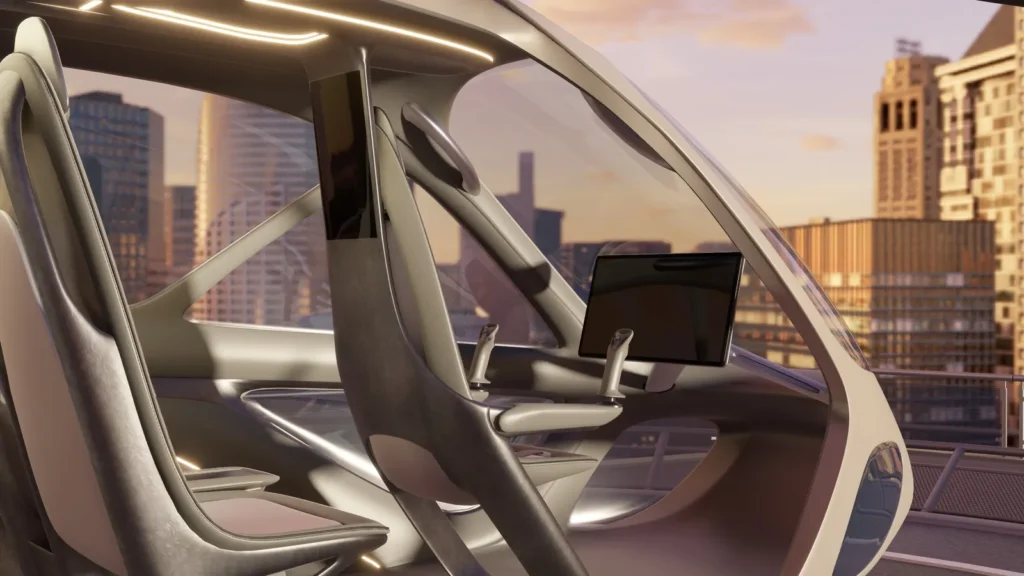
Supernal won’t be the first to market as its targeting a 2028 start, but it could still be a solid bet. Luc Donckerwolke, the Group’s chief creative officer, said after he unveiled a full-size interior prototype at the UK’s Farnborough Air Show: ‘We have the advantage of not being in search of investors, like many of our rivals, so it’s about making the right product at the right time. We have to end up with a product that is actually the most user-friendly.’
Supernal, Supernal.aero
3. Vertical
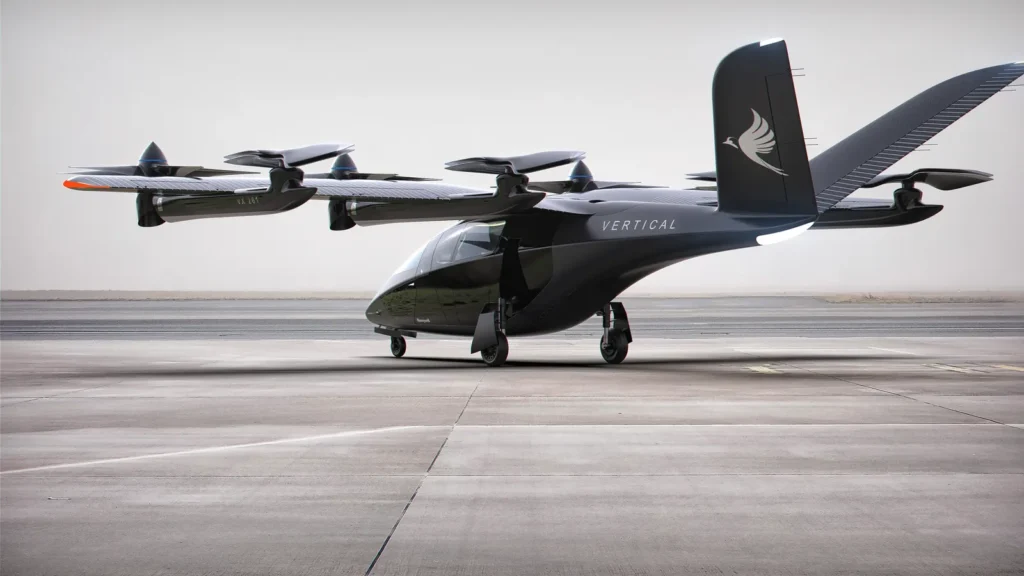
Bristol, UK-based Vertical revealed its first full-size, eight-rotor VX4 prototype at Farnborough 2022, complete with a 100-mile range, 200mph top speed and four-passengers-plus-one-pilot cabin. Claiming to be 100 times safer than a helicopter, first test flights are due this summer before certification and service in 2025.
Vertical’s president Michael Cervanka told Wallpaper* that recharging the battery only takes 15 minutes with its 800-volt system. He predicts that 1000s of eVTOL planes will be in service by 2030 and 10,000-plus in the decade after that, with autonomous technology quickly replacing an onboard pilot. Virgin Atlantic is an early partner.
Vertical Aerospace, Vertical-Aerospace.com
4. Eve
Dedicated eVTOL company Eve unveiled its full-size, four-seater-plus-pilot cabin model at Farnborough. Good for 60 miles on a full charge, with 125mph top speed, the Eve craft is predicted to be in service by 2026. Originally part of Embraer, and still with the Brazilian aviation company as a majority shareholder, Eve is working with Portuguese transport specialists Almadesign to develop a human-centric approach.
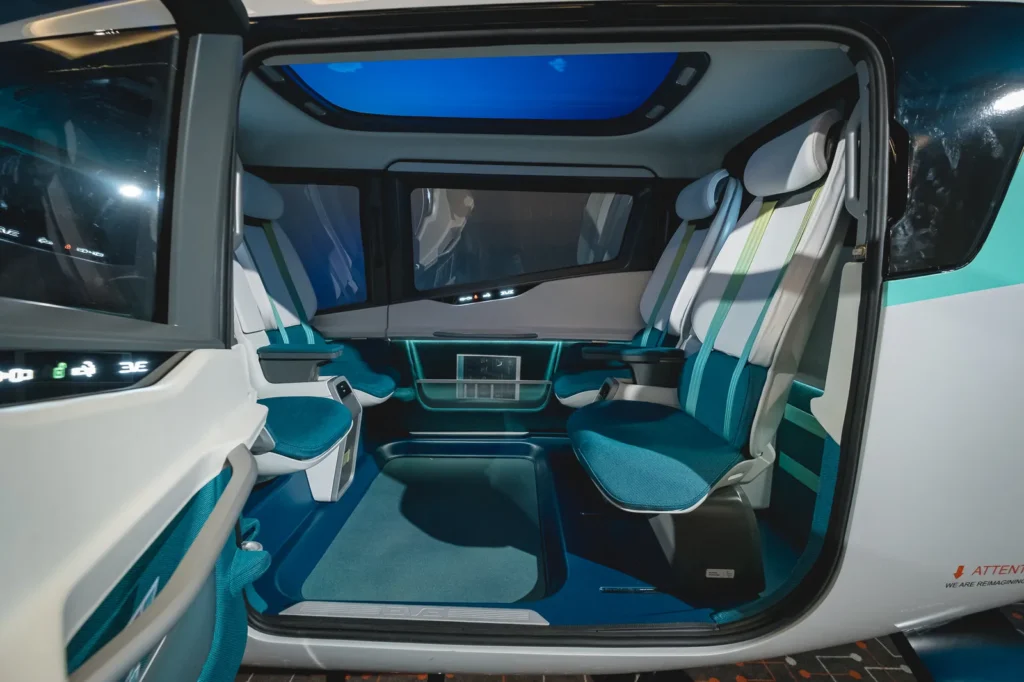
For evidence of that claim, VP of user experience, Flavia Ciaccia, gave examples of design details that include the nearest seat to the door sloping downward not upward to aid entry and exit, and clearly illuminated lock signs on the doors to reassure passengers that its eVTOL is safe to fly.
EVE Air Mobility, EveAirMobility.com
5. Joby Aviation

Joby is one of the most well-established eVTOL firms, with ten years of development experience under its belt. The California-based company aims to be the first to launch a commercial service in early 2024 with a 150-mile max range, one pilot and four passengers, a 200mph top speed and zero emissions in use from its electric six-rotor plane. Uber offloaded its eVTOL Uber Elevate business to Joby in late 2020 while upping its financial stake in the same company and Joby’s plan is to integrate its service into the Uber app, while also delivering rides through its own platform.
The first service will likely be in the US, but in July Joby announced that it is seeking UK certification too. In terms of cost, a Joby spokesperson describes it thus: ‘Our goal, at scale, is to reach $3 per passenger mile, around 2026, although it might start more expensive. Expect it to feel more like Uber Black to begin with and come down to towards normal Uber pricing in due course.’
Joby Aviation, JobyAviation.com
6. Wisk Aero
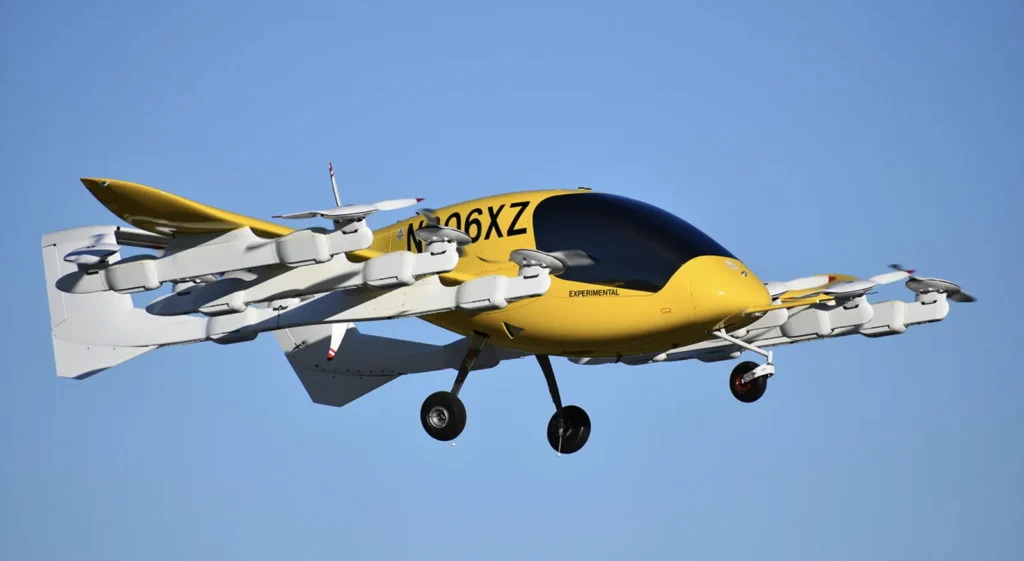
Wisk Aero’s aim is to be the standard-bearer for fully autonomous flying taxis. The US brand has aviation giant Boeing as a majority shareholder, and its fifth-generation, two-seat Cora eVTOL design takes a different approach to larger machines, utilising 12 wing-mounted lifting fans and one aft-mounted pusher propeller.
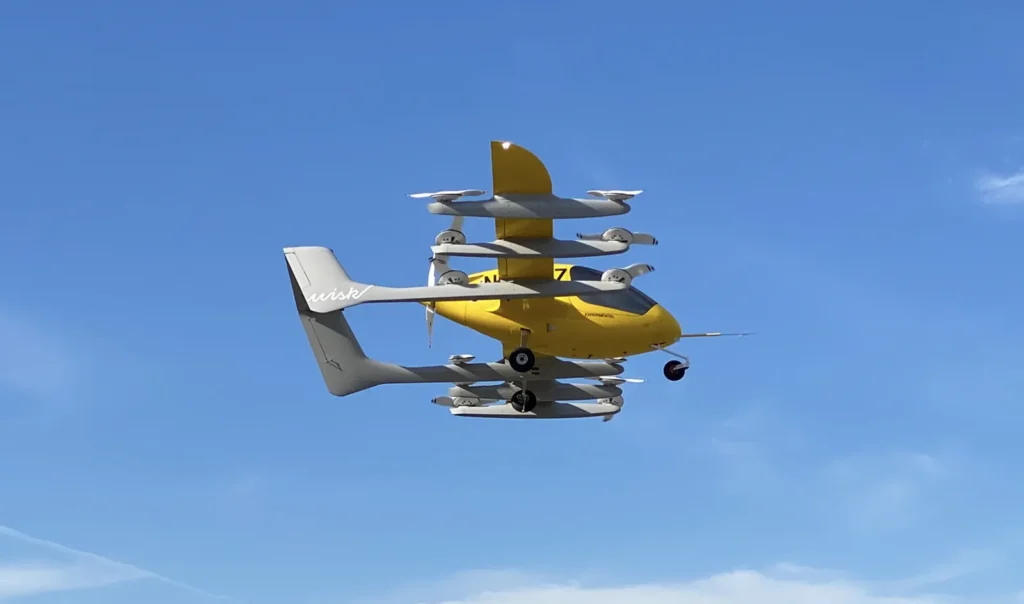
With more than 1,600 test flights already logged the technology is gaining maturity. This Autumn, Wisk will unveil its sixth generation eVTOL with four seats and more luggage space. This is the model is wants to get certified, although no date has been slated for an in-service product.
Wisk Aero [https://wisk.aero/]
7. Volocopter
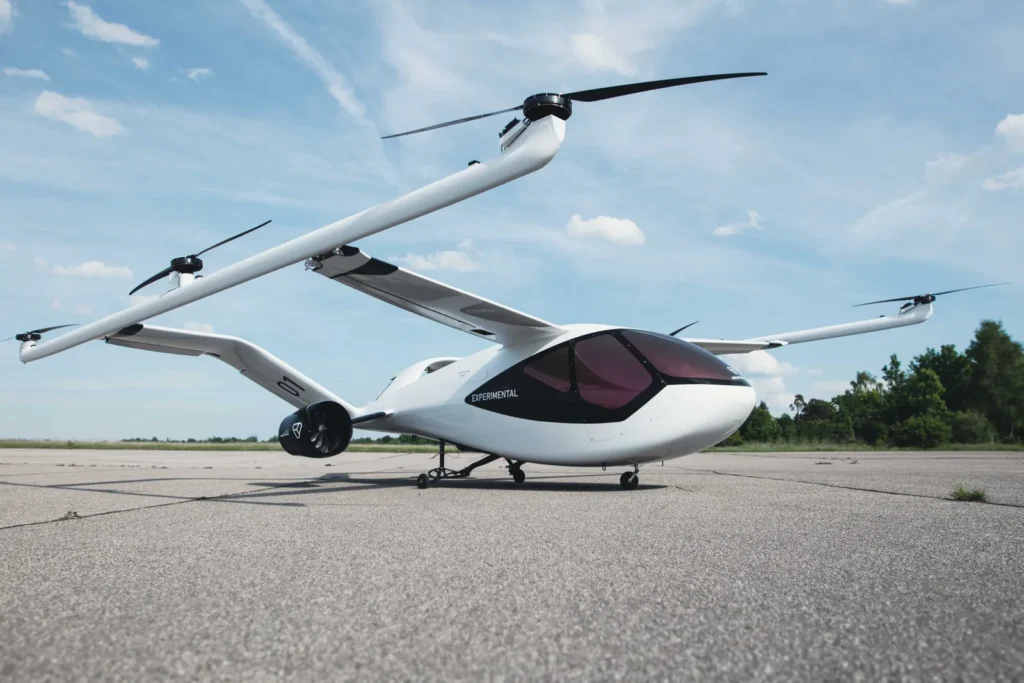
German eVTOL maker Volocopter is another well-established company. Claiming to be the only brand to have a range of eVTOL products at a testing phase, its most recent craft is the four-seater, 60-mile range VoloConnect, which took its first flight in 2022 and is designed to connect suburbs to city centres.
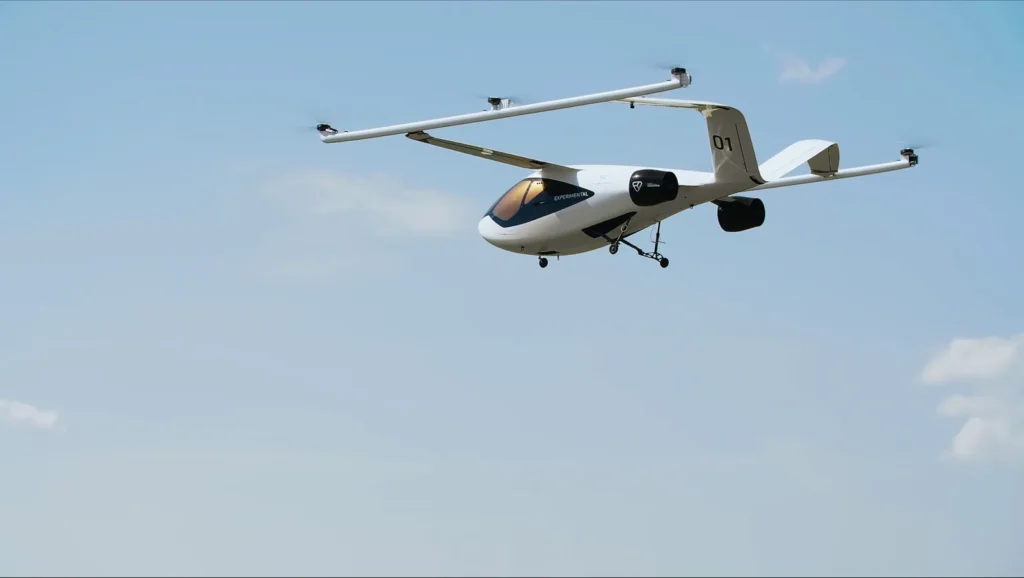
Other products include the 18-rotor, two-seater, inner-city-focused VoloCity and the VoloDrone cargo carrier. The VoloConnect has six rotors for vertical take-off and two electric fans in combination with uplift-creating wings enabling faster forward speeds. Volocopter plans to launch its first commercial flights in Paris and Singapore by 2024.
Volocopter, Volocopter.com
Also Read:
